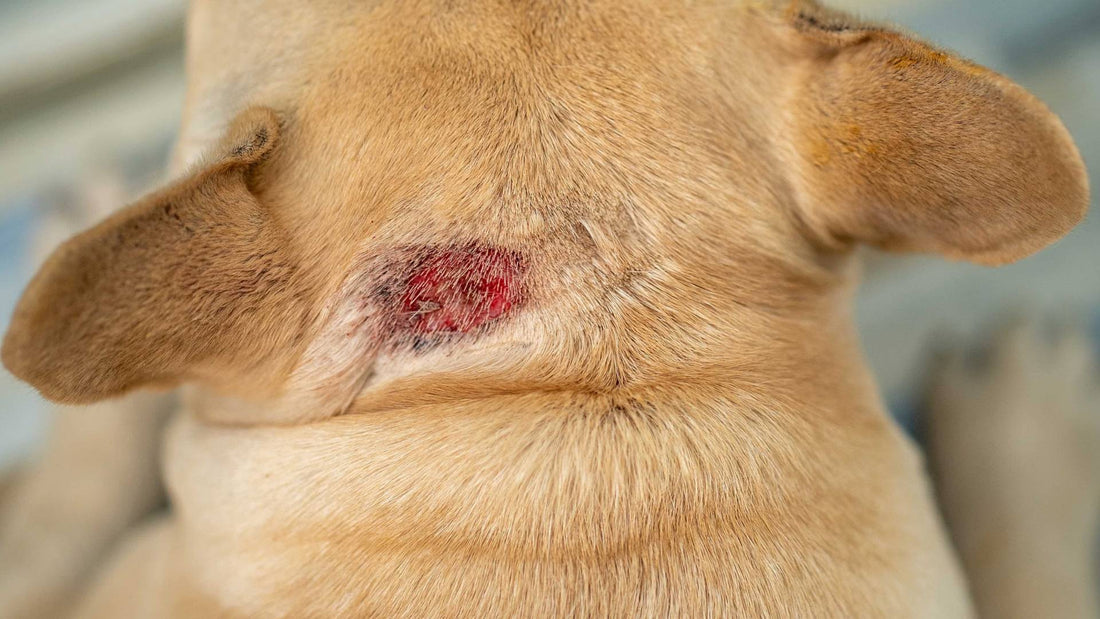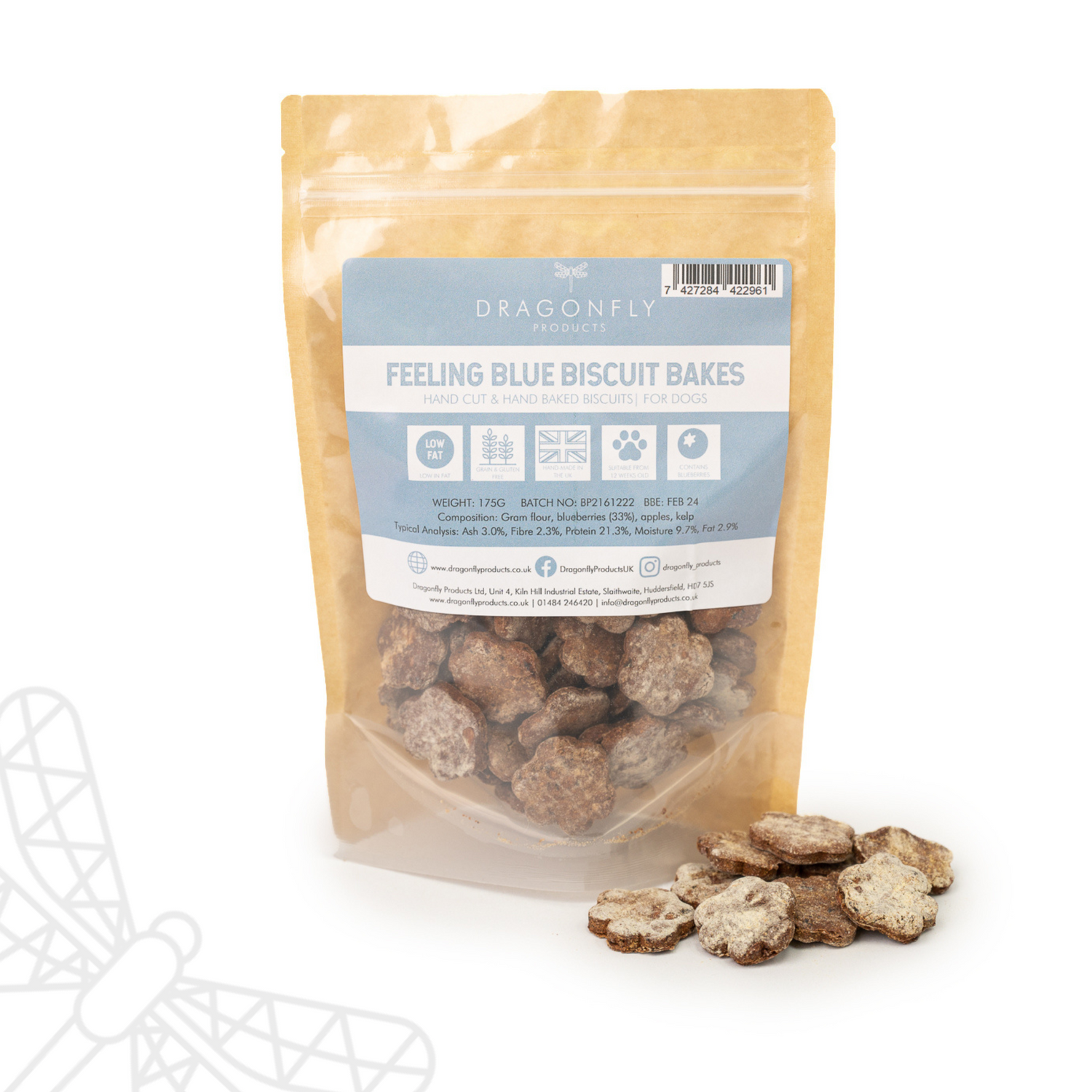
What is a Hot Spot on dogs?
A hot spot, medically known as acute moist dermatitis, is a localised area of inflamed, infected skin. These spots are typically red, moist, and irritated, often causing discomfort and pain for the dog. They can appear suddenly and grow rapidly, especially if the dog continues to lick, chew, or scratch the affected area.
Table of Contents
- Why do dogs get Hot Spots?
- How can you tell if your dog has Hot Spots?
- Where do Hot Spots commonly appear on dogs?
- Are Hot Spots heat related?
- How to treat Hot Spots on dogs?
- Are certain dog breeds prone to Hot Spots?
- Can puppies get Hot Spots?
- Are Hot Spots contagious?
- Can diet cause Hot Spots in dogs?
- How long does it take for a Hot Spot to heal?
Why do dogs get hot spots?
There are six common reasons as to why dogs develop hot spots.
- Allergies: Environmental, food, or flea allergies can cause itching and skin irritation.
- Parasites: Fleas, ticks, and mites can irritate the skin, leading to excessive scratching and hot spots.
- Poor Grooming: Matted fur or skin infections due to poor grooming can create ideal conditions for hot spots.
- Skin Infections: Bacterial or fungal infections can cause or exacerbate hot spots.
- Moisture: Wet fur, whether from swimming, bathing, or rain, can create a breeding ground for bacteria.
- Underlying Health Issues: Conditions like hypothyroidism or immune disorders can predispose dogs to skin problems.
How can you tell if your dog has Hot Spots?
There are a few common signs and symptoms of hot spots to look for in your dog.
- Red, Inflamed Skin: Hot spots are characterised by a bright red colour, indicating significant inflammation. The affected area will be noticeably different from the surrounding healthy skin.
- Moist, Oozing Skin: The area is usually moist or wet to the touch. It may ooze clear fluid, pus, or blood, creating a sticky or crusty appearance as the discharge dries.
- Swelling: The skin around the hot spot may be swollen, raised, and warm to the touch due to inflammation.
- Hair Loss: The fur around the hot spot often falls out or is chewed off by the dog, leaving a bald patch. The surrounding fur may also appear matted and damp from the moisture.
- Edges of the Lesion: The edges of the hot spot can be clearly defined, showing a stark contrast between the affected area and the surrounding healthy skin. The border may appear irregular or well-defined depending on the severity.
- Constant Scratching or Licking: Your dog may obsessively scratch, lick, or chew at the area.
- Pain or Discomfort: Your dog may show signs of pain or discomfort when the area is touched.
Where do Hot Spots commonly appear on dogs?
Hot spots can occur anywhere on a dog's body, but they are most commonly found in areas typically prone to moisture and irritation.
- Head and Ears: Hot spots in these areas might be aggravated by ear infections or allergies. They can appear as raw, moist lesions behind the ears or on the cheeks.
- Neck and Chest: These hot spots are often large and spread quickly, especially in dogs with thick fur. They may appear more extensively matted with fur.
- Hips and Tail Base: Hot spots here might be related to flea allergies. They appear as raw, bald patches with moist, oozing skin and are often irritated by the dog's licking and chewing.
- Abdomen and Groin: During warmer months, hot spots can occur around this area and often start off looking like small insect bites.
Are Hot Spots heat related?
Hot spots get their name from the warmth generated by inflammation rather than external 'hot' weather conditions. While hot spots are not directly caused by heat, warm and humid conditions can exacerbate the underlying issues that lead to hot spots. Moisture trapped in the fur can create a favourable environment for bacteria to thrive, contributing to the development of hot spots.
How to treat Hot Spots on dogs?
Hot spots should be treated with care as they can spread quickly and get infected if not addressed.
- Clip the Fur: Trim the fur around the hot spot to allow the area to breathe and be more easily treated.
- Clean the Area: Gently clean the area with a cooled boiled water to remove debris and bacteria.
- Dry the Area: Keep the area dry to prevent further bacterial growth.
- Apply Medication: Dependent on the severity of the hot spots, use natural antiseptic such as colloidal silver on the affected area. Seek advice from a vet if the hot spots are severe or infected as anti-inflammatory medications or prescribed treatments can promote healing and reduce inflammation.
- Prevent Licking and Scratching: Use an Buster Inflatable Collar to prevent the dog from further irritating the hot spot.
- Address Underlying Causes: Identify and treat any underlying issues such as allergies, parasites, or infections to prevent recurrence.
Are certain dog breeds prone to Hot Spots?
Yes, some breeds are more prone to hot spots due to their coat type, skin folds, and predisposition to allergies or other skin conditions. Breeds commonly affected include:
- Golden Retrievers
- Labrador Retrievers
- German Shepherds
- St. Bernards
- Rottweilers
- Bulldogs
These breeds often have dense undercoats, skin folds, or are prone to allergies, making them more susceptible to hot spots.
Can puppies get Hot Spots?
Yes, puppies can get hot spots. While hot spots are more common in adult dogs, puppies are also susceptible to developing these painful skin lesions.
Are Hot Spots contagious?
Hot spots themselves are not contagious, but the underlying causes, like parasites or infections, can be. It's important to address the root cause to prevent the parasite or infection spreading, rather than the actual hot spots which are a symptom.
Can diet cause Hot Spots in dogs?
Yes, a poor diet can contribute to skin problems, including hot spots. Ensuring your dog has a balanced diet rich in essential fatty acids, vitamins, and minerals can help maintain healthy skin and coat. It is also worth considering whether your dog has an intolerance to something within the diet that is causing the hot spots.
How long does it take for a Hot Spot to heal?
With proper treatment, most hot spots begin to heal within a few days. Complete healing typically takes 1 to 2 weeks, depending on the severity of the hot spot and the effectiveness of the treatment.
Hot spots on dogs are a common but treatable condition. Recognising the signs early and addressing the underlying causes can help keep your dog comfortable and prevent further complications. Regular grooming, parasite control, and monitoring for allergies are key in managing and preventing hot spots in dogs.
For any further help and advice please contact us on 01484 246420 and why not join our social media channels and online community on Instagram, Facebook or YouTube.
With Wags and Woofs,
Laura, Dolly & Reggie


